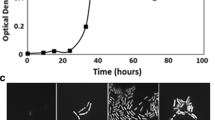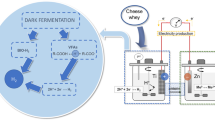Abstract
The oxidoreduction potential (E h) is of growing interest in dairy research and the dairy industry. Lactic acid bacteria are able to decrease the E h to considerable reducing values, and it is an important feature of the technological characteristics of lactic starters and probiotics. Reducing E h is also necessary for the development of the characteristic flavour of certain fermented dairy products such as cheeses. Moreover, data comparisons and interpretations are often difficult due to an absence of standardised expression of the results. The objective of this work was to propose a complete procedure for the use of combined and half-cell platinum (Pt) sensors to obtain stable, repeatable and reproducible E h measurements and to standardise data. Three measurement systems, each made up of a sensor, cable and interface, were compared in tap water. A control chart was used to calculate a confidence interval (CI = 20 mV) to verify whether the process was under control. This complete procedure was then applied to the measurement of E h in milk samples to characterise both pure strains of lactic acid bacteria and complex mixed starters, to study the impact of a process parameter (oxygen) on starter activity, to follow E h during cheese making and to measure E h gradients in cheeses. This manuscript presents a procedure for the measurement of E h as well as the feasibility and interest of this procedure in the dairy chain.






Similar content being viewed by others
References
Abraham S (2007) Evolution du potentiel d'oxydoréduction dans le lait au cours de la transformation fromagère: impact des composants intrinsèques et des bactéries lactiques. University of Burgundy, Dijon, France
Abraham S, Cachon R, Colas B, Feron G, DeConinck J (2007) E h and pH gradients in camembert cheese during ripening: measurements using microelectrodes and correlations with texture. Int Dairy J 17:954–960
Aubert C, Capelle N, Jeanson S, Eckert H, Diviès C, Cachon R (2002) Le potentiel d'oxydo-réduction et sa prise en compte dans les procédés d'utilisation des bactéries lactiques. Sci Aliment 22:177–187
Bolduc M-P, Bazinet L, Lessard J, Chapuzet J-M, Vuillemard J-C (2006) Electrochemical modification of the redox potential of pasteurized milk and its evolution during storage. J Agric Food Chem 54:4651–4657
Bourel G, Henini S, Diviès C, Garmyn D (2003) The response of Leuconostoc mesenteroides to low external oxidoreduction potential generated by hydrogen gas. J Appl Microbiol 94:280–288
Brasca M, Morandi S, Lodi R, Tamburini A (2007) Redox potential to discriminate among species of lactic acid bacteria. J Appl Microbiol 103:1516–1524
Cachon R, Jeanson S, Aldarf M, Divies C (2002) Characterisation of lactic starters based on acidification and reduction activities. Lait 82:281–288
Caldeo V, McSweeney PLH (2012) Changes in oxidation–reduction potential during the simulated manufacture of different cheese varieties. Int Dairy J 25:16–20
Dave RI, Shah NP (1997a) Effect of cysteine on the viability of yoghurt and probiotic bacteria in yoghurts made with commercial starter cultures. Int Dairy J 7:537–545
Dave RI, Shah NP (1997b) Effectiveness of ascorbic acid as an oxygen scavenger in improving viability of probiotic bacteria in yoghurts made with commercial starter cultures. Int Dairy J 7(6–7):435–443
Ebel B, Martin F, Le LDT, Gervais P, Cachon R (2011) Use of gases to improve survival of Bifidobacterium bifidum by modifying redox potential in fermented milk. J Dairy Sci 94:2185–2191
Galster H (1991) pH measurement: fundamentals, methods, applications, instrumentation (edited by Ebel HF). V.C.H. Verlagsgesellschaft mbH, Weinheim, DEU
Galster H (2000) Techniques of measurement, electrode processes and electrode treatment. In: Schüring J, Schultz HD, Fischer WR, Böttcher J, Duijnisveld WHM (eds) Redox: fundamentals, processes and applications. Springer, Berlin, pp 13–23
Jacob HE (1970) Redox potential. In: Norris JR, Ribbons DW (eds) Methods in microbiology, vol. 2. Academic, London, pp 91–123
Jeanson S, Hilgert N, Coquillard M, Seukpanya C, Faiveley M, Neveu P, Abraham S, Georgescu V, Fourcassie P, Beuvier E (2009) Milk acidification by Lactococcus lactis is improved by decreasing the level of dissolved oxygen rather than decreasing redox potential in the milk prior to inoculation. Int J Food Microbiol 131:75–81
Kieronczyk A, Cachon R, Feron G, Yvon M (2006) Addition of oxidizing or reducing agents to the reaction medium influences amino acid conversion to aroma compounds by Lactococcus lactis. J Appl Microbiol 101:1114–1122
Ledon H, Ibarra D (2006) Method for modifying hygienic, physico-chemical and sensory properties of cheese by controlling the redox potential. France Patent WO2006106252, 2006
Leistner L, Mirna A (1959) Das redoxpotential von pökelladen. Die Fleischwirtschaft 8:659–666
Martin F, Cayot N, Marin A, Journaux L, Cayot P, Gervais P, Cachon R (2009) Effect of oxidoreduction potential and of gas bubbling on rheological properties and microstructure of acid skim milk gels acidified with glucono-δ-lactone. J Dairy Sci 92:5898–5906
Martin F, Cayot N, Vergoignan C, Journaux L, Gervais P, Cachon R (2010) Impact of oxidoreduction potential and of gas bubbling on rheological properties of non-fat yoghurt. Food Res Int 43:218–223
Martin F, Cachon R, Pernin K, De Coninck J, Gervais P, Guichard E, Cayot N (2011) Effect of oxidoreduction potential on aroma biosynthesis by lactic acid bacteria in nonfat yogurt. J Dairy Sci 94:614–622
Michelon D, Abraham S, Ebel B, DeConinck J, Husson F, Feron G, Gervais P, Cachon R (2010) Contribution of exofacial thiol groups in the reducing activity of Lactococcus ssp. lactis. FEBS J 277:2282–2290
Monnet C, Schmitt P, Diviès C (1994) Diacetyl production in milk by an alpha-acetolactic acid accumulating strain of Lactococcus lactis ssp. lactis biovar. diacetylactis. J Dairy Sci 77:2916–2924
Schreyer A, Britten M, Chapuzet J-M, Lessard J, Bazinet L (2008) Electrochemical modification of the redox potential of different milk products and its evolution during storage. Innov Food Sci Emer Technol 9:255–264
Spinnler H, Corrieu G (1989) Automatic method to quantify starter activity based on pH measurement. J Dairy Res 56:755–764
Tachon S, Michelon D, Chambellon E, Cantonnet M, Mezange C, Henno L, Cachon R, Yvon M (2009) Experimental conditions affect the site of tetrazolium violet reduction in the electron transport chain of Lactococcus lactis. Microbiology 155:2941–2948
Tango MSA, Ghaly AE (1999) Amelioration of lactic acid production from cheese whey using micro-aeration. Biomass Bioenergy 17:221–238
Tengerdy R (1961) Redox potential changes in 2-keto-l-gulonic acid fermentation—I. Correlation between redox potential and dissolved oxygen concentration. J Biochem Microbiol Technol Eng 3:241–253
Tscale EG, Aly NA (1996) An expert system model for implementing statistical process control in the health care industry. Computers and Indust Eng 31:447–450
Acknowledgments
The authors wish to thank Mr Nicolas Adami (Mettler-Toledo) for his comments on this manuscript. The thesis of Cécile Aubert was supported by a research grant from the ANRT. The thesis of Sophie Abraham was supported by research grants from INRA, the Regional Council of Burgundy (Dijon, France) and the Regional Council of Franche-Comté (Besançon, France). The authors are grateful to Gaby Duboz and Francis Faurie (INRA-URTAL, Poligny, France) for making the cheeses in the pilot plant and also to César Grandvoynet for his technical help. The thesis of Damien Michelon was supported by a EUREKA research grant (Σ!3562-Labredox). The thesis of Bruno Ebel was supported by research grants from Senoble (Jouy, France), the ANRT (Paris, France) and the FUI Probiotique, supported by Vitagora. This work was partly supported by a research grant from ANR (Food-Redox project), supported by Vitagora (Dijon, France) and Valorial (Rennes, France).
Author information
Authors and Affiliations
Corresponding author
About this article
Cite this article
Abraham, S., Cachon, R., Jeanson, S. et al. A procedure for reproducible measurement of redox potential (E h) in dairy processes. Dairy Sci. & Technol. 93, 675–690 (2013). https://doi.org/10.1007/s13594-013-0134-5
Received:
Revised:
Accepted:
Published:
Issue Date:
DOI: https://doi.org/10.1007/s13594-013-0134-5




